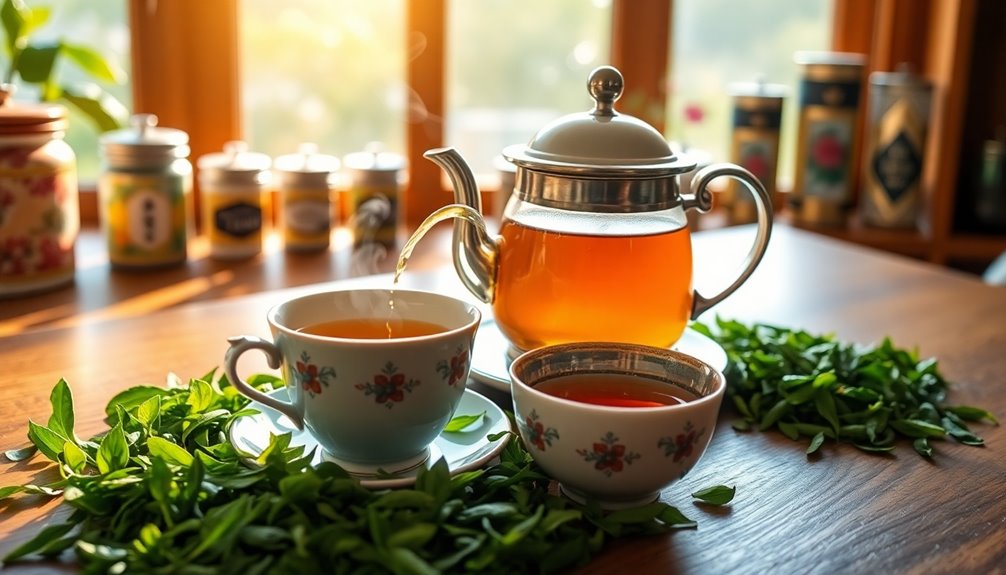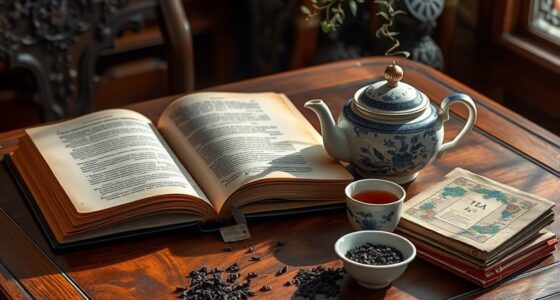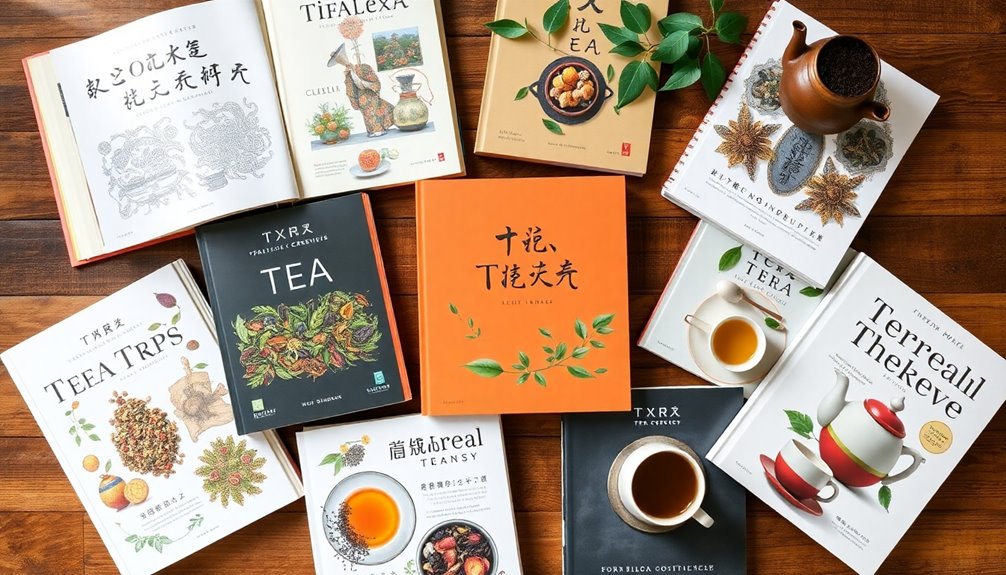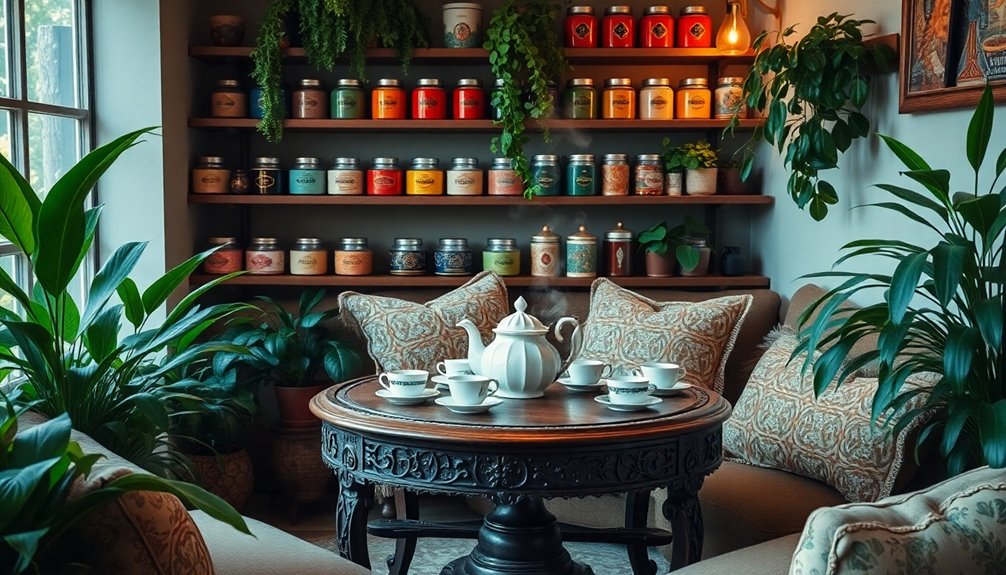Tea literature connects history, culture, and flavor by revealing how tea has shaped societies and rituals over centuries. It captures the essence of ancient practices, like the Chinese tea ceremonies that blend philosophy with social customs. You can see how different cultures, from British Afternoon Tea to Moroccan mint tea, use this beverage to create bonding experiences. It even influences poetry, infusing emotion and reflection into artistic expressions. Each cup you enjoy tells a story, enriched by tradition and flavor. Discovering more about these connections can deepen your appreciation for the tea you sip.
Key Takeaways
- Tea literature reflects the beverage's historical evolution, revealing its transformation from a simple drink to a complex cultural artifact.
- Various literary works illustrate tea's role in social rituals, emphasizing its importance in fostering community and connection across cultures.
- Poets often use tea as a motif, exploring themes of comfort and reflection while linking the beverage to nature and human emotion.
- The cultural significance of tea is highlighted through narratives that underscore its impact on traditions and social practices in different societies.
- Discussions on tea's flavor often intertwine with historical and cultural contexts, showcasing how taste influences social interactions and personal experiences.
Introduction
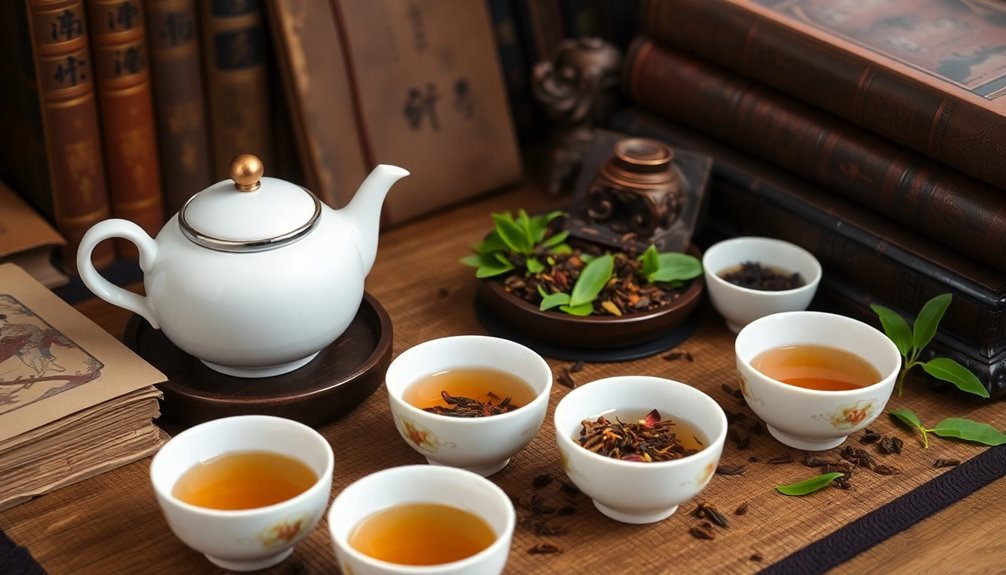
In the world of literature, tea serves as more than just a beverage; it's a rich symbol woven into the fabric of countless narratives. Your journey through tea literature reveals its deep-rooted history, tracing back to ancient Chinese culture where works like *The Classic of Tea* by Lu Yu elevated tea appreciation to an art form.
The cultural significance of tea extends globally, showcasing its flavors and traditions that connect diverse societies.
As you explore iconic scenes, like those in *Alice's Adventures in Wonderland*, you notice how tea acts as a cultural touchstone, facilitating social gatherings and interactions. This symbolism often reflects broader themes of comfort, resilience, and tradition, demonstrating tea's ability to unite people from various backgrounds.
Contemporary tea literature continues to delve into the intricate relationships between tea and cultural practices, revealing how this simple beverage maintains its relevance in modern society.
You'll find that tea is more than just a drink; it encapsulates history, flavors, and the essence of human connection. Through these narratives, you'll appreciate how tea transcends mere consumption, enriching the literature it graces and the lives it touches.
Tea's Role in Social Rituals
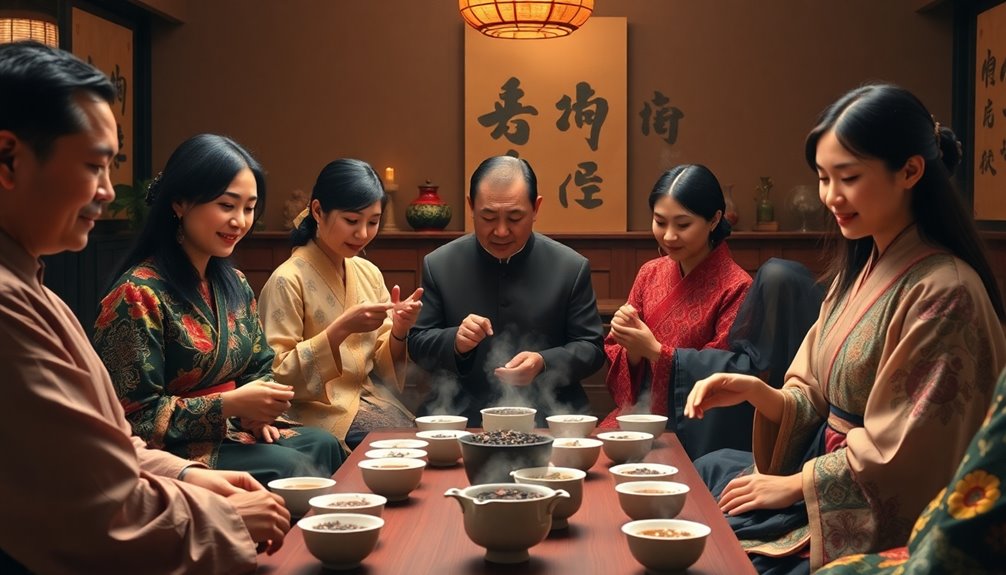
Tea plays a pivotal role in social rituals worldwide, acting as a bridge that connects people and cultures. In Japan, the tea culture is epitomized by the Japanese tea ceremony (Chanoyu), where matcha is prepared with an emphasis on harmony and mindfulness. This ritual creates a serene environment that fosters respect among participants.
In Morocco, mint tea symbolizes hospitality and is served in a ritualistic manner, often poured from a height to create froth. This practice enhances social interactions during communal gatherings, making every sip a shared experience.
Similarly, Indian chai rituals bring families and communities together, with spiced tea serving as both a comforting beverage and a daily tradition.
British Afternoon Tea, established in the Victorian era, combines tea with sandwiches and pastries, showcasing hospitality while creating an opportunity for social connection.
Meanwhile, Turkish tea culture thrives in communal settings, where tea served in tulip-shaped glasses encourages conversation and bonding among guests.
Through these diverse social rituals, tea transcends mere flavor, becoming a vital element that strengthens relationships and cultural identity across the globe.
Tea's Impact on Social Cohesion
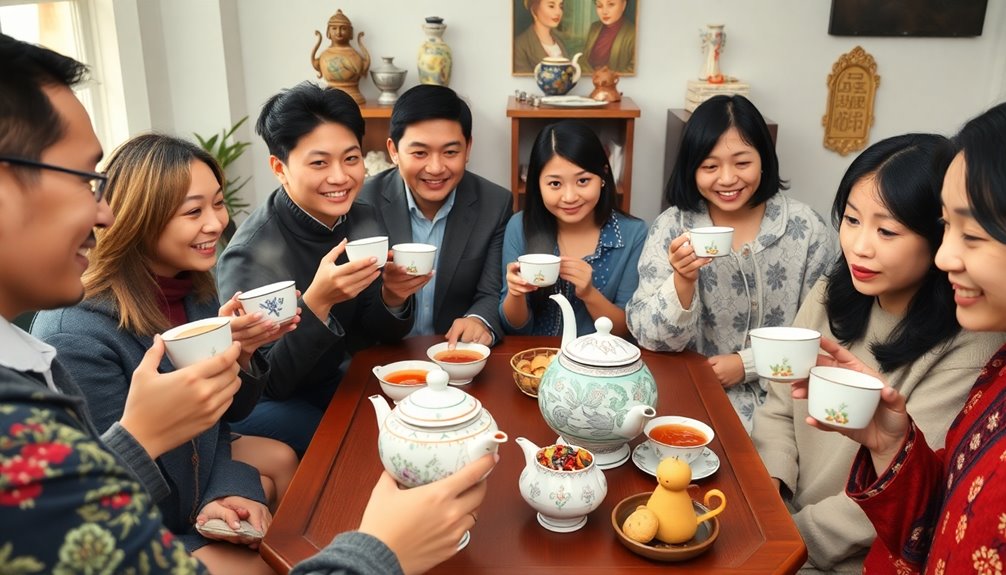
While many might see tea simply as a beverage, it actually plays a crucial role in fostering social cohesion across various cultures.
In Chinese society, for instance, tea serves as a social lubricant, facilitating discussions and strengthening relationships during gatherings. The cultural significance of tea is evident in Japan's tea ceremonies (Chanoyu), where mindfulness and respect create a tranquil space that enhances community bonds.
Similarly, Moroccan Mint Tea symbolizes hospitality. Its ritualistic preparation reinforces social ties, welcoming guests into homes with warmth and generosity.
British Afternoon Tea, which emerged in the Victorian era, transforms tea into a social event, combining it with food to nurture friendships and provide opportunities for interaction.
Tea traditions like Indian Chai and Turkish tea rituals further illustrate how tea acts as a medium for connection. These rituals create a shared experience that unites diverse communities, transcending cultural barriers.
Ultimately, tea's impact on social cohesion lies in its ability to bring people together, fostering a sense of belonging and creating lasting memories.
Tea's Influence on Poetry
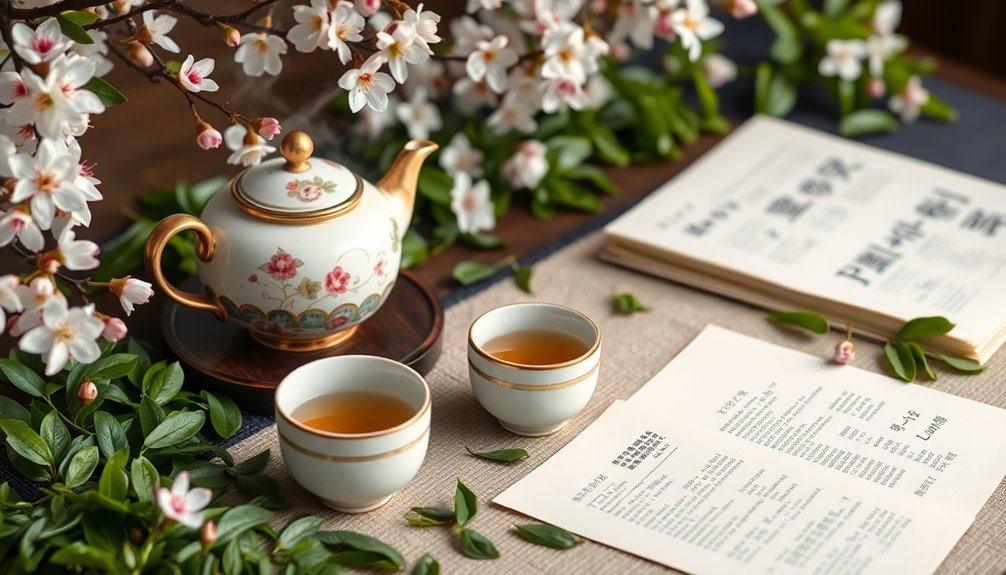
Numerous poets have found inspiration in the simple act of tea drinking, weaving its symbolism into their verses to evoke comfort, reflection, and a sense of time's passage. Across cultures, tea represents a ritualistic practice that connects people, encouraging mindfulness and fostering poetic expression.
In the Tang dynasty, poets celebrated tea's flavors, intertwining their experiences with nature and emotion. The Japanese tea ceremony, or Chanoyu, is a prime example; it serves as a backdrop for poetic gatherings, where participants share haikus and engage in meaningful dialogue while enjoying tea.
This ritual creates a space for healing and connection, allowing individuals to reflect on domesticity and the intimate moments tea brings. In English literature, poets like T.S. Eliot and John Keats have utilized tea as a motif, exploring deeper themes through its comforting presence.
Contemporary poets continue this tradition, drawing on tea's ability to create pauses in our fast-paced lives, offering solace and connection. By celebrating tea in their poetry, these writers capture its essence, illustrating how this humble beverage enriches our culture and deepens our experiences.
Cultural Appropriation of Tea Practices
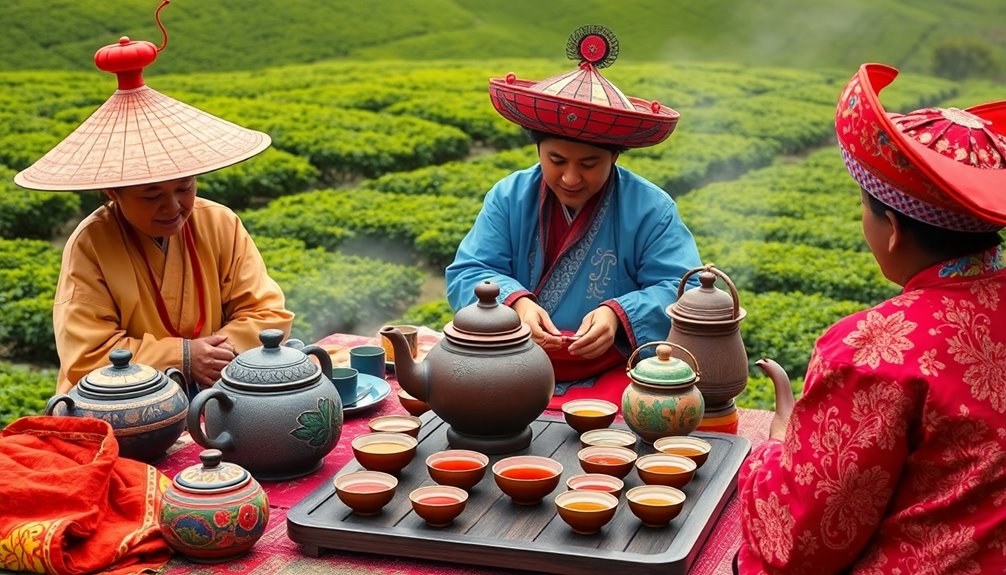
Cultural appropriation of tea practices often manifests when traditional ceremonies, like the Japanese Chanoyu, are adopted without a genuine understanding of their historical significance. This lack of comprehension can dilute the cultural meaning and create misconceptions about the rituals.
In Western societies, the commercialization of tea rituals, such as afternoon tea, often overlooks the nuanced social customs that are integral to their origins, including hospitality and social bonding in British culture.
As globalization facilitates the spread of tea practices, we see the emergence of hybrid forms that may celebrate diversity. However, these blends can raise concerns about authenticity and risk erasing the cultural roots associated with indigenous tea practices.
When you adopt elements of different tea traditions, it's crucial to respect the histories and values of the tea-drinking communities involved.
Discussions around cultural appropriation remind us of the importance of honoring the authentic traditions of tea practices. By acknowledging their cultural significance, you ensure that these practices aren't overshadowed by commercialization, thereby fostering a deeper appreciation for the rich, diverse heritage of tea.
Understanding these complexities helps preserve the integrity of tea practices for future generations.
Practical Applications

Understanding the cultural significance of tea practices can greatly enhance your appreciation of its literary representations. When you immerse yourself in tea literature, you'll notice how it reflects various cultural practices and social interactions.
Engaging in your own tea rituals can deepen your connection to these narratives, allowing you to experience mindfulness similar to that found in the Japanese tea ceremony.
Explore different tea varieties—green, black, oolong, and white—and pay attention to their unique flavors. This exploration can serve as a metaphor for cultural identity and personal growth, just as many literary works illustrate.
Consider hosting a tea gathering focused on hospitality rituals, where you invite friends to share stories and experiences, reminiscent of the iconic Mad Hatter's tea party.
Incorporating sustainability and ethical sourcing into your tea choices not only aligns with modern literature's themes but also fosters a responsible approach to enjoying this beloved beverage.
Conclusion
In exploring tea literature, you've uncovered how this humble beverage weaves through history and culture, shaping social rituals and inspiring poetry. You've seen how tea fosters connections among people and highlights the complexities of cultural appropriation. By appreciating these links, you can deepen your understanding of tea's rich heritage and its role in everyday life. So, next time you sip your favorite brew, remember the stories and traditions it carries with every warm, comforting cup.



